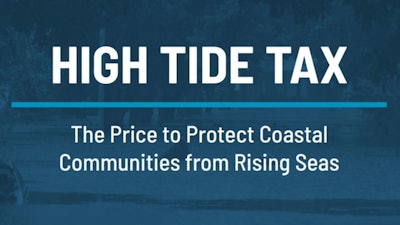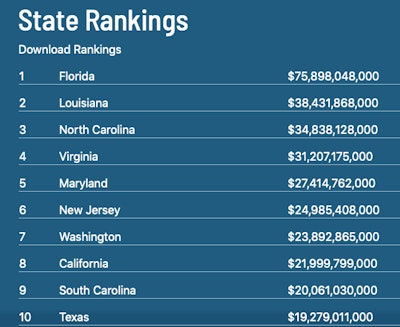
Coastal communities in the contiguous U.S. face more than $400 billion in costs over the next 20 years, much of it sooner, to defend coastal communities from inevitable sea-level rise, according to a report released today by the Center for Climate Integrity in partnership with the engineering firm, Resilient Analytics.
The expected cost is approaching that of the original interstate highway system. It will require construction of more than 50,000 miles of coastal barriers in 22 states by 2040, half the time it took to create the nation’s iconic roadway network. Moderate sea-level-rise projections for the year 2040 identified 132 counties where costs will exceed $1 billion, 178 small communities where the cost of building basic coastal defenses is more than $100,000 per person.Center for Climate Integrity
Moderate sea-level-rise projections for the year 2040 identified 132 counties where costs will exceed $1 billion, 178 small communities where the cost of building basic coastal defenses is more than $100,000 per person.Center for Climate Integrity
The first-of-its-kind report titled, “High Tide Tax: The Price to Protect Coastal Communities from Rising Seas” includes rankings of the estimated sea-level rise adaptation costs by city, county, congressional district, and state. Using moderate (not worst-case) sea-level rise projections for the year 2040 and storm surge expected to be seen every year, the report identified 132 counties where costs will exceed $1 billion, and 14 states where costs for these minimal defenses will exceed $10 billion. The top ten states are listed below, complete rankings can be found here.
For hundreds of small coastal and tidal communities identified in the report, the costs will far outstrip their ability to pay, making retreat and abandonment the only viable option unless enormous amounts of financing emerge in a very short period of time. As just one example of the scope and gravity of this problem, in 178 small communities the cost of building basic coastal defenses is more than $100,000 per person.
Florida is by far the most heavily impacted state, with costs reaching nearly $76 billion statewide; 23 counties facing at least $1 billion in seawall expenses alone; and 24 communities where building just this rudimentary level of coastal protection will cost more than $100,000 per person.
Republican and Democratic congressional districts are hit roughly evenly. There are 71 districts facing more than $1 billion in seawall expenses by 2040: seven of the top 10 and 24 of the top 40 are currently represented by Republicans. Overall, 41 are represented by Democrats and 30 are represented by Republicans.
“Our collective failure to come to grips with the massive costs of climate adaptation is the latest, and most delusional form of climate denial,” said Richard Wiles, executive director of the Center for Climate Integrity.
The situation may turn out to be much worse. Sea levels could easily rise more than the estimates used in the study; they are very unlikely to rise less. And many localities will protect for more damaging storms than the modest one-year storm surge used in this analysis.
“The cost estimates presented here are just a small portion of the total adaptation costs these local and state governments will be forced to finance,” said Paul Chinowsky, PhD, lead engineer on the project.
“The companies that made and promoted the products that they knew would irrevocably and radically alter the global climate, and then denied it, must pay their fair share to help communities adapt to it”, said Wiles. “Failing to hold polluters to this basic responsibility would be to knowingly bankrupt hundreds of communities, standing idly by as they are slowly and inexorably swallowed up by the sea,” Wiles added.
To read the full report and view the full data set, which includes cost estimates for 2040, 2060, 2100 as well as other RCP and storm surge scenarios, https://www.preventionweb.net/publications/view/66090.

















